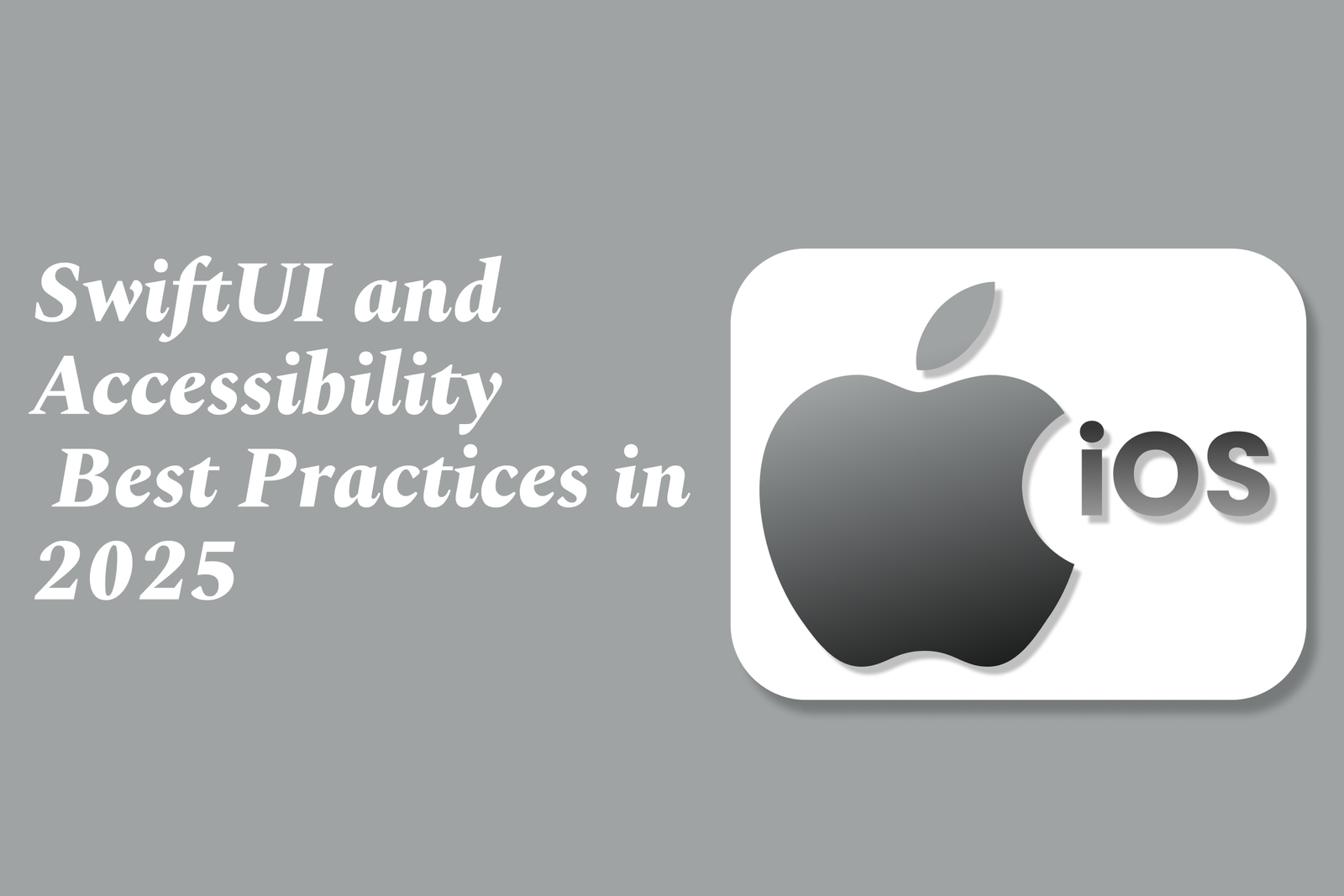SwiftUI and accessibility: Best practices in 2025
SwiftUI in 2025 empowers developers to build inclusive apps with declarative syntax, native support for accessibility features, dynamic type, and customizable animations. Best practices emphasize clear labels, semantic grouping, testing, and respecting user preferences for an optimal accessible experience.
SwiftUI and Accessibility: Best Practices in 2025
1 ) Understanding SwiftUI's Accessibility Foundations
SwiftUI is Apple's declarative UI framework enabling developers to create beautiful, consistent, and responsive apps across Apple platforms with minimal code. Since accessibility is integral to great app experiences, SwiftUI incorporates built in support that developers can leverage to build inclusive applications from the ground up.
2 ) Declarative Syntax and Accessibility
SwiftUI uses a declarative syntax that allows developers to describe the UI structure clearly, making it easier to include accessibility attributes. For instance, developers can attach accessibility modifiers directly to views, specifying labels, hints, and traits that voice over and assistive technologies use. This clear syntax facilitates maintaining and updating accessibility features as the app evolves.
3 ) Animating with Accessibility Considerations
SwiftUI simplifies animations, making it easier to add dynamic behavior without complex code. However, in 2025 best practices emphasize ensuring animations do not interfere with accessibility — such as enabling reduced motion preferences and providing alternatives for animations that might trigger vestibular disorders or distract users with cognitive disabilities.
4 ) Supporting Dynamic Type and Color Schemes
SwiftUI inherently supports Dynamic Type, scaling fonts based on user settings for readability. Additionally, SwiftUI adapts seamlessly to system dark and light modes. Developers should verify that custom color schemes and UI elements maintain adequate contrast and readability under all display modes to comply with WCAG 2.1 and beyond.
5 ) Leveraging New Accessibility APIs and Features
In 2025, SwiftUI integrates with the latest accessibility APIs, including detailed control over accessibility focus, custom rotor support for easier navigation, and improved semantic grouping of UI elements. Developers are encouraged to use these APIs to provide richer, more navigable interfaces that accommodate different disabilities.
6 ) Testing and Validation are Crucial
Automated tools and manual testing remain essential for ensuring accessibility compliance. Developers should utilize Xcode's Accessibility Inspector, VoiceOver testing, and external audit tools aligned with the 2025 Web Content Accessibility Guidelines (WCAG 2.1 and upcoming updates). Early testing in the development cycle helps identify barriers before release.
7 ) Inclusive Design Beyond Compliance
Accessibility in SwiftUI is not just about meeting legal requirements but about creating experiences usable and enjoyable by everyone. Best practices in 2025 include designing for cognitive and learning disabilities, providing clear content structure, meaningful labels, and ensuring interactive elements are easily discoverable and operable.
8 ) Continuous Education and Community Resources
The SwiftUI and accessibility landscape continues to evolve. Developers should engage with community resources, tutorials, and courses, staying updated on best practices. Sharing knowledge and challenges fosters a culture committed to building truly accessible digital experiences.
Summary:
SwiftUI empowers developers with powerful, straightforward tools to build accessible apps. Best practices in 2025 focus on leveraging declarative syntax to add semantic accessibility information, ensuring animations respect user preferences, supporting dynamic type and dark mode effectively, utilizing new accessibility APIs for enhanced navigation, rigorous testing for compliance, and embracing inclusive design principles that extend beyond mere standards compliance. Continuous education and community engagement are vital to advancing accessibility efforts within the SwiftUI ecosystem.
https://justacademy.in/news-detail/android-system-permissions-overview
https://justacademy.in/news-detail/flutter-hackathons-&-winners-in-2025
https://justacademy.in/news-detail/performance-testing-in-flutter-4.0
https://justacademy.in/news-detail/how-react-native-is-powering-the-future-of-smart-home-apps
https://justacademy.in/news-detail/swift-concurrency-updates:-what-to-expect
Related Posts
In 2025, top Angular libraries offer modern, feature-rich components and tools for building dynamic web apps. From powerful data grids to low-code platforms like UI Bakery, these libraries enhance development speed, UI design, and scalability, making them essential for Angular developers.
Migrating from AngularJS to Angular 17 involves gradually upgrading your app by running both frameworks together using tools like ngUpgrade, rewriting components in TypeScript, and adopting Angular’s modern architecture to enhance performance, maintainability, and long-term support.
Angular state management tools help organize and handle app data efficiently, improving scalability and maintainability. Popular options include NgRx for robust, RxJS-based patterns, and newer Signal Store solutions that offer simpler, reactive approaches integrated tightly with Angular’s latest features.
RxJS in Angular empowers developers to manage asynchronous data streams with powerful operators like `forkJoin`, `combineLatest`, and `zip`. Mastering these key operators in 2025 is essential for building efficient, reactive applications that handle complex event sequences seamlessly.
Angular performance optimization in 2025 focuses on improving app speed and responsiveness by using techniques like OnPush change detection, lazy loading, efficient data caching, and AOT compilation. These practices reduce load times, enhance user experience, and ensure scalable, fast Angular applications.
In 2025, Angular remains preferred for large-scale, enterprise apps with its robust, all-in-one framework, while Vue attracts developers seeking simplicity and fast development for smaller projects. Both frameworks excel, with choice driven by project needs and team expertise.
Angular Signals are a new reactive primitive in Angular 16 that enable fine-grained, efficient change detection by automatically tracking dependencies and updating only affected parts of the UI. They simplify state management and boost app performance, revolutionizing Angular's reactivity model.
Angular interview questions to prepare in 2025 focus on core concepts like components, directives, data binding, routing, and dependency injection, along with TypeScript mastery and latest Angular features to ensure strong practical knowledge for building scalable, efficient web applications.
AngularJS reached its official end of support in January 2022, meaning no further updates or security patches. To ensure app security and performance, developers should consider migrating to modern Angular versions or seek third-party long-term support options if immediate migration isn’t possible.
The Angular Roadmap 2025 highlights upcoming features focused on improving developer experience and performance, including zoneless Angular, Signals integration, enhanced Forms, async data handling, improved HMR, and expanded Angular Material/CDK enhancements, driving modern, efficient web app development.










